Blog article
9 eCommerce Conversion Rate Optimization Tools (CRO) Chosen by Experts to Increase Sales in 2024
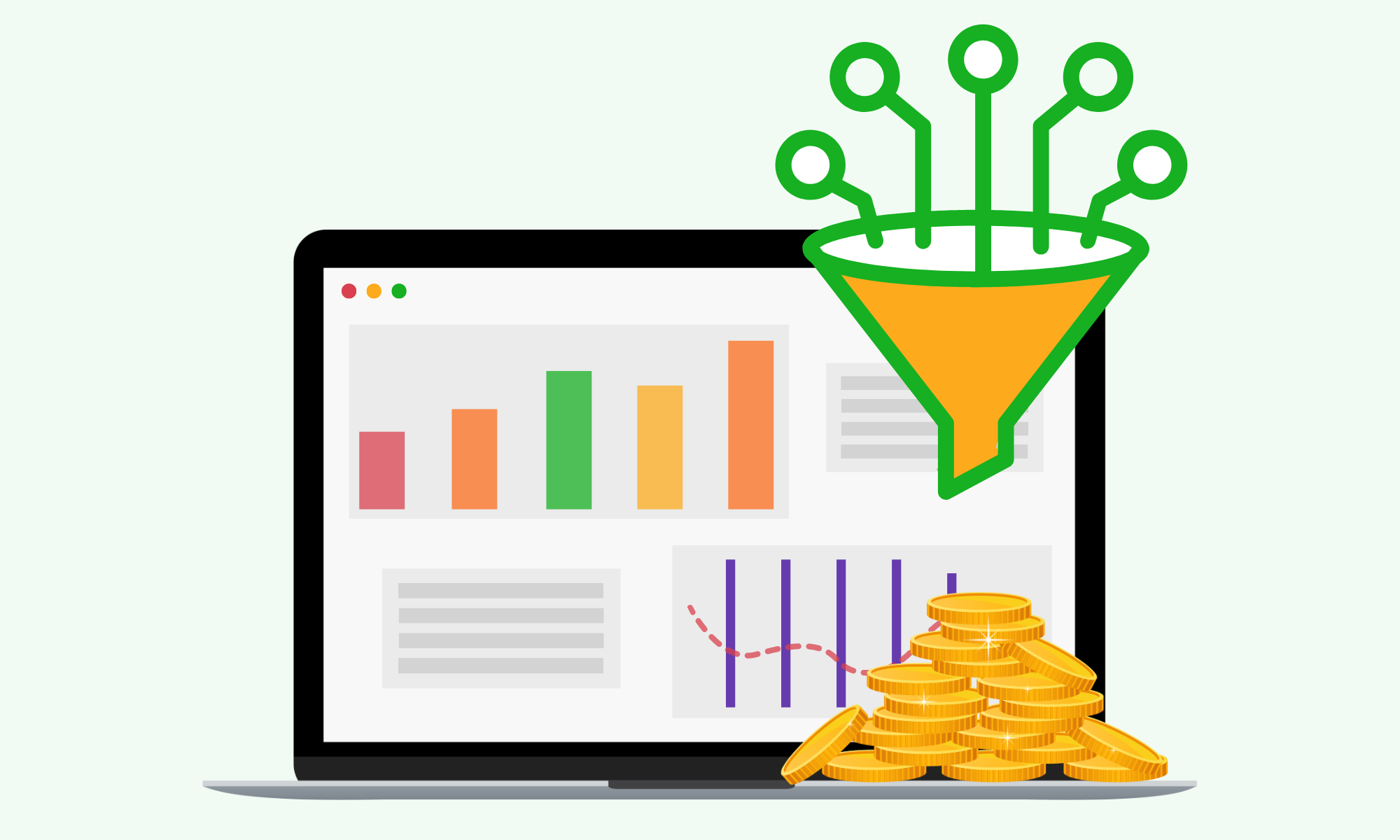
Conversion rate optimization, when it’s well executed, ensures that your eCommerce business is on the right track. You’ll notice a steady increase in sales, and the long-term benefits will make your initial efforts to attract visitors more worthwhile. However, manually optimizing conversion rates is time-consuming, costly, and challenging to scale effectively.
As eCommerce grows, teams end up throwing more and more money by missing a proper Conversion Rate Optimization of their landing or product pages.
Choosing the right conversion rate optimization tool can help you scale up your sales without spending much more because you already have a site, and a product to sell. You just need to do it the right way. However, choosing the right conversion rate optimization tool is tricky.
In this post, we’ll share what we’ve found to be the most important factors to consider when choosing a conversion rate optimization tool. We listed the best 9 we know.
IF YOU WANT TO START A/B TESTING WITH AI TO INCREASE THE CONVERSION RATE OF YOUR PRODUCT PAGES AS SOON AS POSSIBLE, REQUEST A VMAX PRODUCT DEMO WITH OUR SPECIALIST. OUR TOOL CAN HELP YOU FIND THE PERFECT LAYOUT FOR YOUR PRODUCT PAGES AND CUSTOMIZE THEM BASED ON YOUR VISITORS’ ATTRIBUTES.
9 Conversion Rate Optimization Tools designed for E-commerce
1. Verbolia – Automated Layout Testing To Boost Conversions (From Paid & Organic Traffic)
Verbolia helps you to increase the conversion rate of product landing pages. In this section, we’ll explain how it works.
In short, Verbolia has 2 solutions for eCommerce:
- A PPC solution that helps you test and improve different product layout for your paid traffic campaigns;
- An organic traffic solution that helps you to publish long-tail product listing pages. Both will support your conversion optimization efforts. Let’s see how.
Conversion Rate Optimization In Paid Channels (PPC)
The goal of Verbolia is to make the conversion rate optimization be as high possible by showing your visitors the most relevant products. Verbolia’s Vmax AI-powered technology will help you to test and show different product layouts for your paid channels such as Google Shopping Ads.
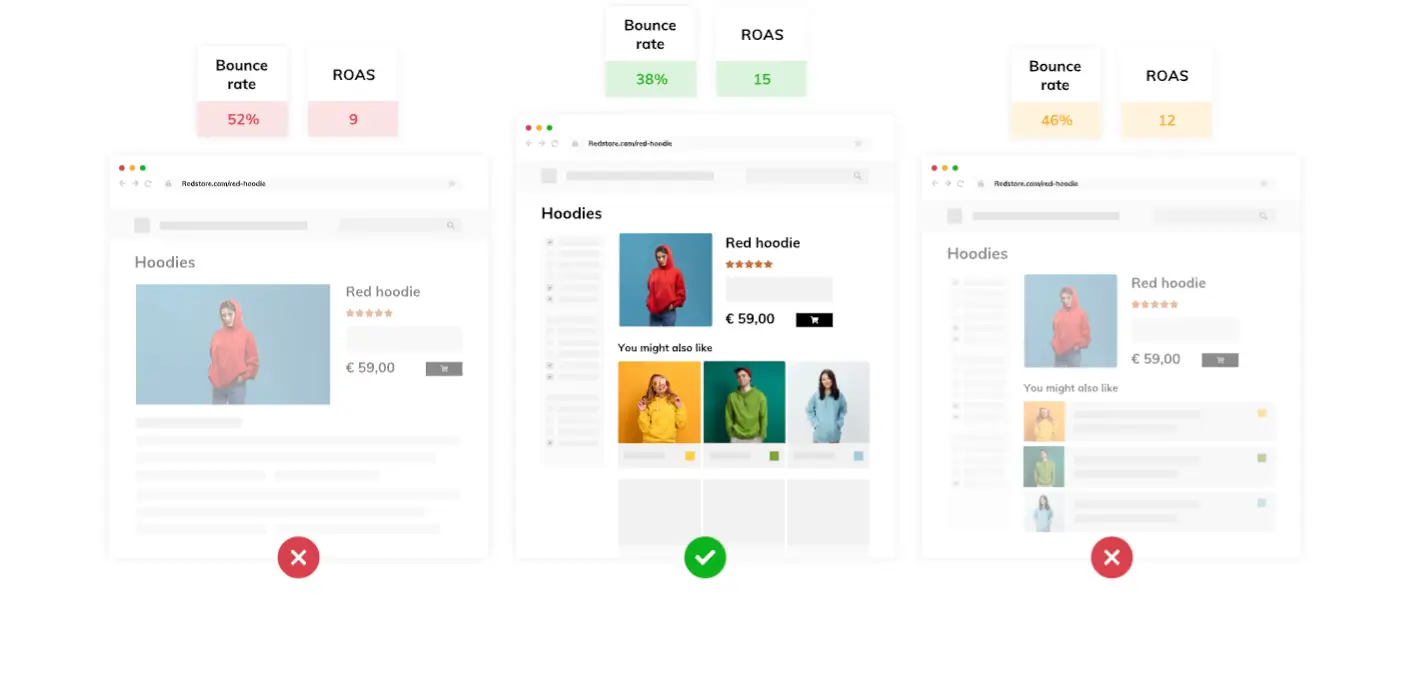
The image above is an example of how Verbolia Vmax works for PPC chanels: it takes the best performing layout to lower bounce rate and increase conversion rates.
If your product landing pages are performing poorly (high bounce rates, low conversion rates) you can use Vmax by Verbolia to increase the ROAS of your Google Shopping Campaigns with its integrated A/B testing technology.
Vmax will A/B test multiple product landings showing different product recommendations as well as product filters, and based on the tests, Verbolia’s Vmax will help you to choose the best product landing layout.
With Verbolia’s Vmax, your bounce rates and conversion rates will be improved automatically for all your product landings, so your ROAS will improve and your overall paid budget will be spent more accurately.
💡Increase conversion rates with the best product recommendation engine
How does the Verbolia Vmax algo detect conversion rate upgrades? It is simple, thanks to a JavaScript embedded into your website’s HTML header code.
The code snippet will detect the right moment to show the layout tests on multiple product landing pages, then the algorithm will decide which one is the best for each scenario.

The screenshots above show the before (left) and the after (right) of the final result of Verbolia Vmax product landing pages based on users behavior with automated AB testing.
As you can see the layout in the left is not optimal for paid traffic: user is not able to see more suggested products above the fold and might bounce back to Google when not satisfied with the product.
In the right picture you can see right away: product filters to easily navigate the webshop and recommended products above the fold. Perfect to keep the users attention for a few extra seconds.
Brico Privé tested our solution for 3 months by running A/B testing on a group of 500 top-clicking products. They managed to reach a Conversion rate increase of 48%, and a revenue increase of +109% year over year. But based on their feedback, our tool could be “easily adaptable to a catalog of several tens of thousands of products.”
Conversion Rate Optimization In Organic Channels (SEO)
Verbolia also has a solution for organic channels. You can use Verbolia also to optimize the conversion rate of your organic traffic.
Doing SEO at scale is now easier with Verbolia. How? With Verbolia’s software to create SEO-optimized pages for long tail keywords.
The longer the search query, the more qualitative the traffic you will get, which eventually will help you to improve conversion rates directly from customer acquisition.
Here’s how the SEO tool of Verbolia works:
You will be able to create product listing pages (PLP or category pages) where you can show the products that match the search intent of the user.
1. You upload your eCommerce catalog to Verbolia.
2. Get insights on your current keywords with your regular keywords tool (like Semrush, Ahrefs, SE ranking).
3. Upload your target keywords to Verbolia, those you want to use to create new PLP pages at scale.
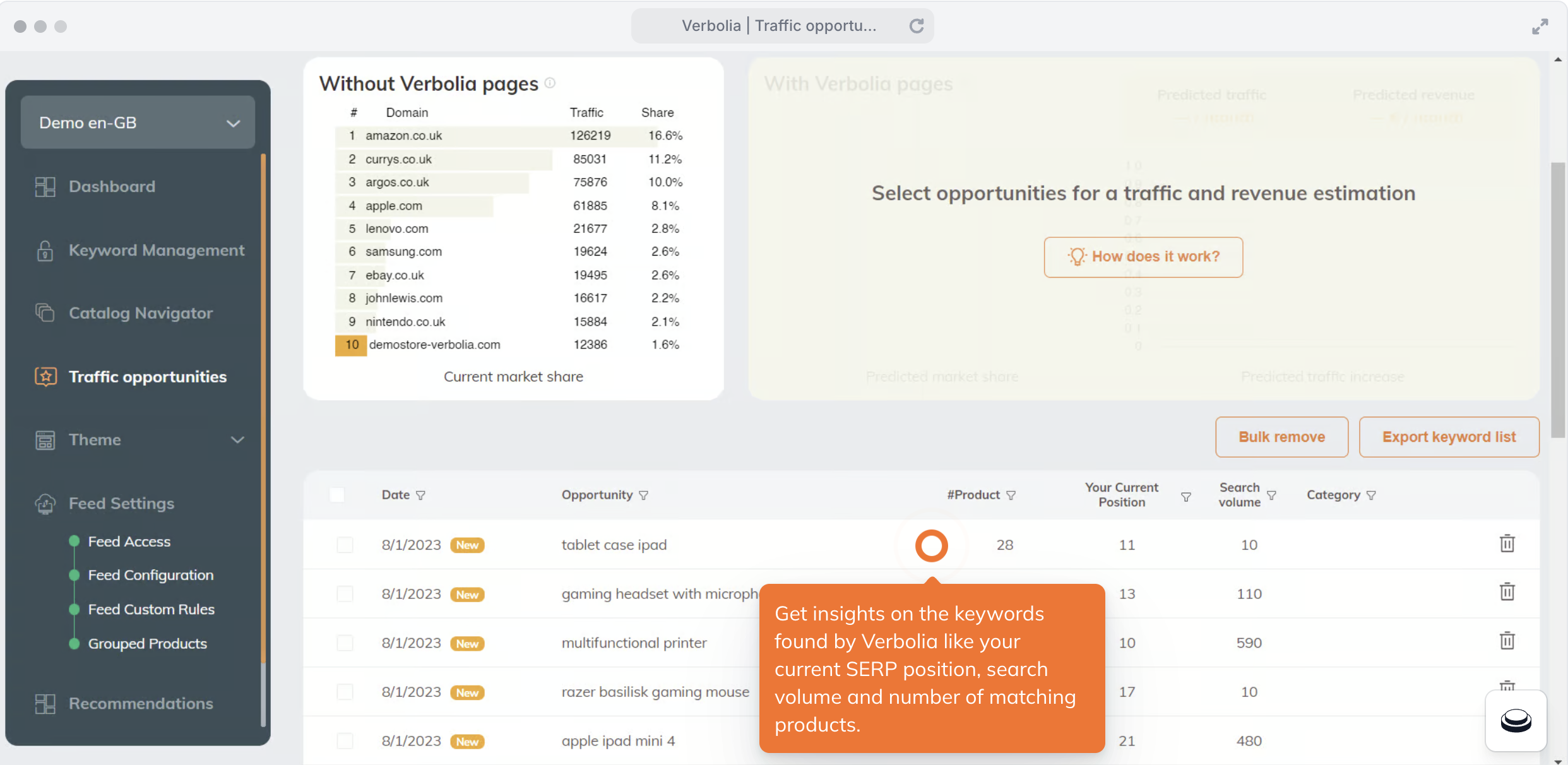
Keywords found by Verbolia that you could use to create new PLP pages at scale.
4. Get an overview of predicted traffic you could achieve if you create a dedicated listing page per keyword.
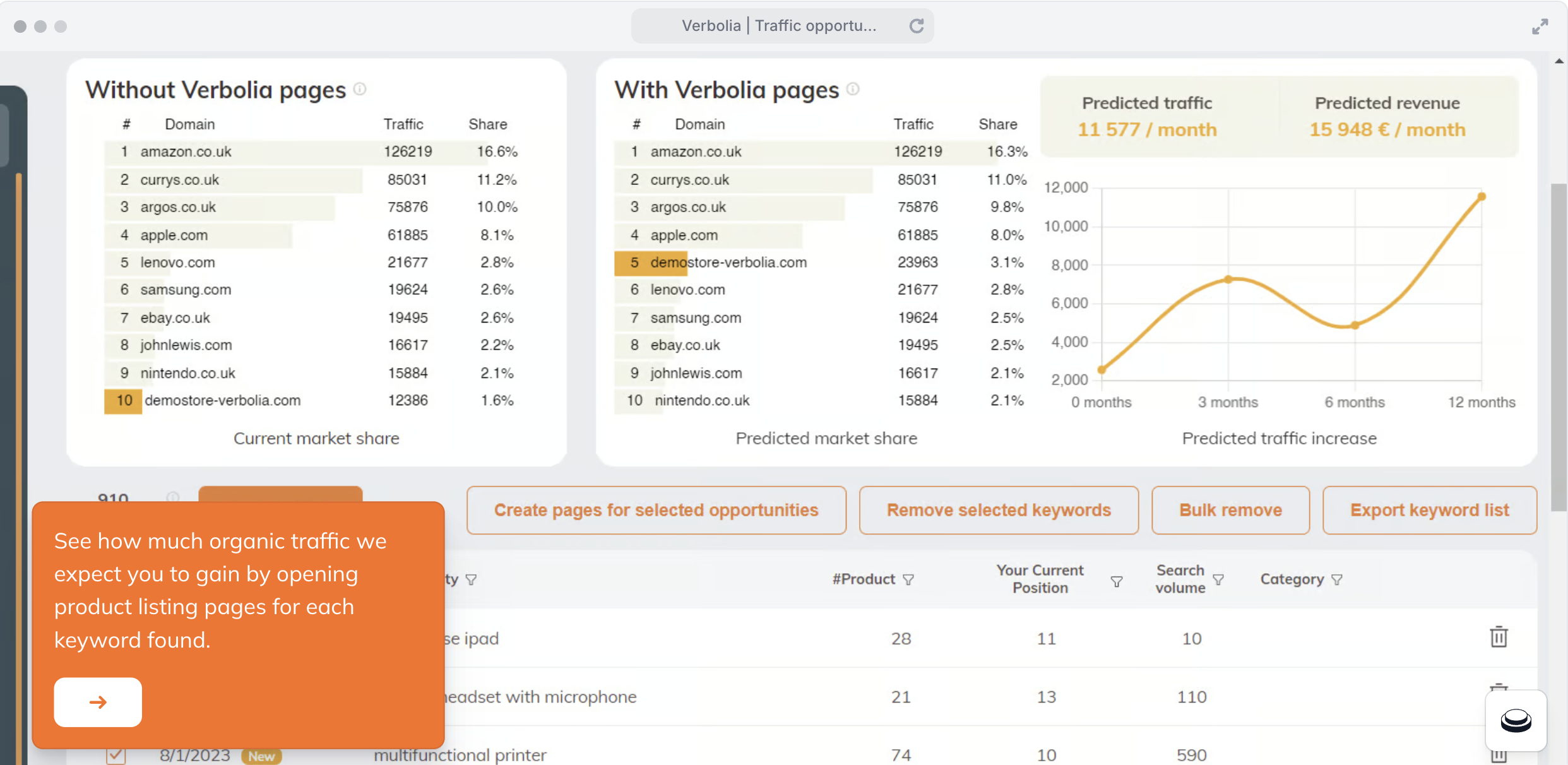
An overview of predicted traffic in case you target long-tail keywords suggested by Verbolia.
5. Choose the keywords from your catalog that you want to target with an auto-generated page.
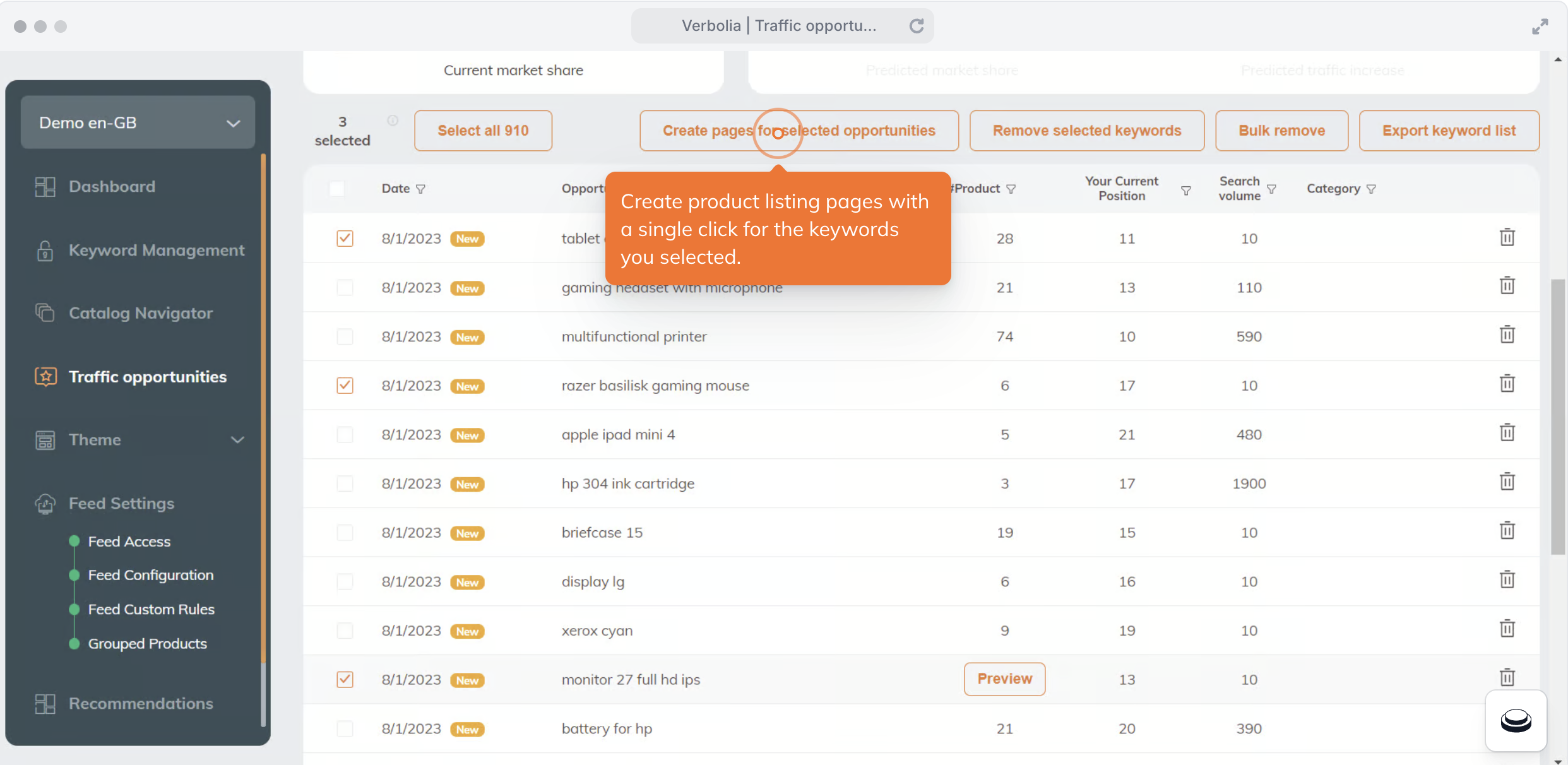
Long tail keywords selection to create AI-generated pages for your ecommerce.
6. Set merchandising rules to create pages full of relevant products targeting long-tail keywords with a higher conversion rate potential.
Verbolia is built with the clear goal of reducing the bounce rate and increasing the conversion rate of your eCommerce website with the expertise of our specialists and AI integration, making your work easier.
So if you need a tool that helps you boost the conversion rate of your eCommerce PPC campaigns or SEO campaigns with the integration of AI, Verbolia could be the choice for you. Request a product Verbolia demo.
💡For you: Learn how to decrease your bounce rate
Verbolia Online Reviews
Our team has invested a great deal of time and energy into ensuring that the A/B testing software improves your eCommerce conversion rate, the onboarding process is seamless, and the interface is user-friendly.
We’re glad that many Vmax users notice this, as proven by the high rating this A/B testing tool has received. 
Source: softwarereviews.com
2. Kameleoon
If you see that your eCommerce Pages’ Conversion rate is not there yet, Kameleoon could be the tool for you (we talk about it also in your list of best A/B testing tools).
To install it you’ll need to insert a line of code into your website code, and you’re ready to go.
This CRO tool allows you to create variations of your original product page that are targeted to specific pages only or based on a specific type of site visitor.
By customizing your product pages based on a specific type of visitor, you can create the perfect page and increase your conversion rate.
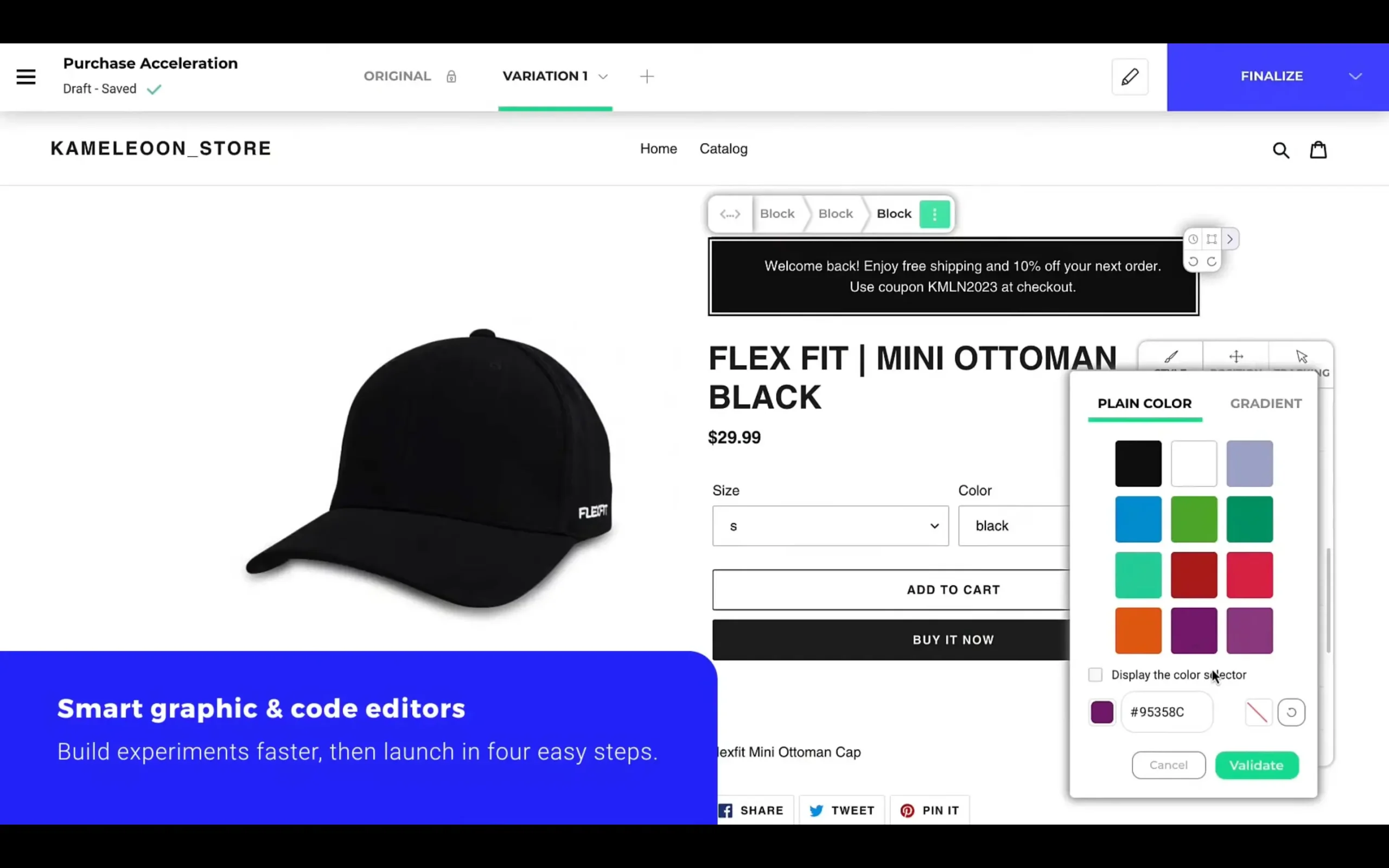
Kameloon’s visual editor for editing your product pages.
You can also decide the site traffic allocation between the original page and the variations while performing the test between different variations of the same page.
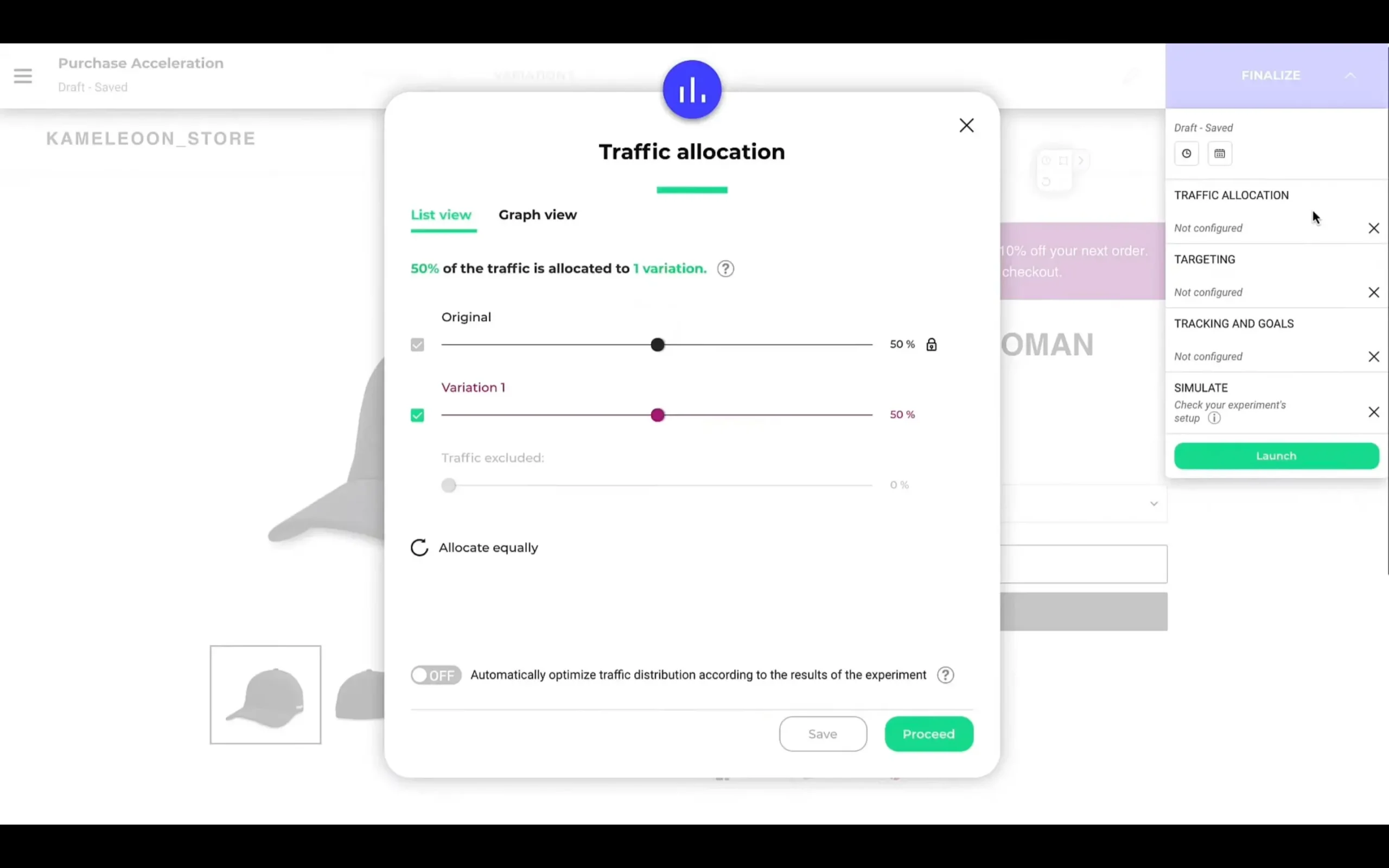
Site traffic allocation decision within Kameleoon.
Once the test is launched, Kameleoon will provide you with the statistical results you need to understand what is rocking, and what needs to be improved.
Implement the changes based on the results, and you’ll be able to see if the conversion rate changes somehow.
Pros of Kameleoon:
- AI-Assisted: Kameleoon’s AI can assist you in predicting user behavior, analyzing your tests telling you what to improve, and can even generate some changes to your pages.
- Robust A/B testing features as you can see from the screenshots above.
- Advanced personalization features.
Cons of Kameleoon
- AI Assistance is not complete: You still need to roll out the suggestions by yourself. It’s not like Verbolia’s AI which takes care of everything, even changing your page’s layout.
- Steep initial learning curve: It’s a tool with many features and tools.
- Costly: The cost of premium features may be prohibitive for smaller businesses
So if you need a tool that lets you do A/B testing with concrete AI support, and you don’t need an AI doing the layout customization and product suggestion for you, Kameleoon could be a good choice for you.
3. VWO (Visual Website Optimizer)
VWO allows you to perform A/B testing on your tool to find the most performing layouts.
With VWO you can run multiple A/B tests at the same time, but you can also change the positioning and elements on a web page using the visual editor (it has some preset widgets), or by inserting custom JS code.
Once the A/B test is completed, you can analyze the results and adjust your pages accordingly. Optimizing based on user data will help you to offer better UX and increase conversion rates on your paid campaigns (PPC) or organic strategies (SEO).
Pros of VWO:
- Fully Custom AB Tests: With VWO you can run multiple A/B tests at the same time. You can change the positioning and elements on a web page using the visual editor (it has some preset widgets), or by inserting custom JS code. Once the A/B test is completed, you can analyze the results and adjust your pages accordingly.
- Usability Heatmaps: If you need heatmaps to understand how your visitors interact with the site, you can get them with an additional subscription to VMO Insights (free if you have less than 5000 monthly tracked visitors). If you have more than 5k tracked visitors, prices start at $214/month.
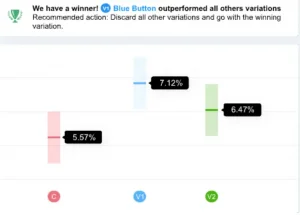
An A/B test result using VWO to compare the most efficient color for a page button.
Cons of VWO:
- Changes have to be done manually with the visual editor since you don’t have an algorithm doing the work for you.
- Manual Layout Upload: The initial layout must be uploaded manually. Would be better to have a team doing it for you so you don’t have to worry about any technical integration work.
- Generalistic: VWO is not specifically tuned for eCommerce product detail pages, but for any kind of web pages that need to generate conversions.
If you can do the layout design and data analysis yourself and don’t need a team and AI doing it for you (as Verbolia does), then this A/B testing tool could be a good option.
4. Crazy Egg
Here’s an example of an A/B testing tool that allows you to do things like analyze visitor behavior, record visitors, and edit page layouts.
To start using Crazy Egg, you just need to install it on your website builder (WordPress, Wix, Squarespace, and Shopify are all compatible).
To analyze the customer experience on your site with Crazy Egg, you have several tools like heatmaps or scrollmaps.
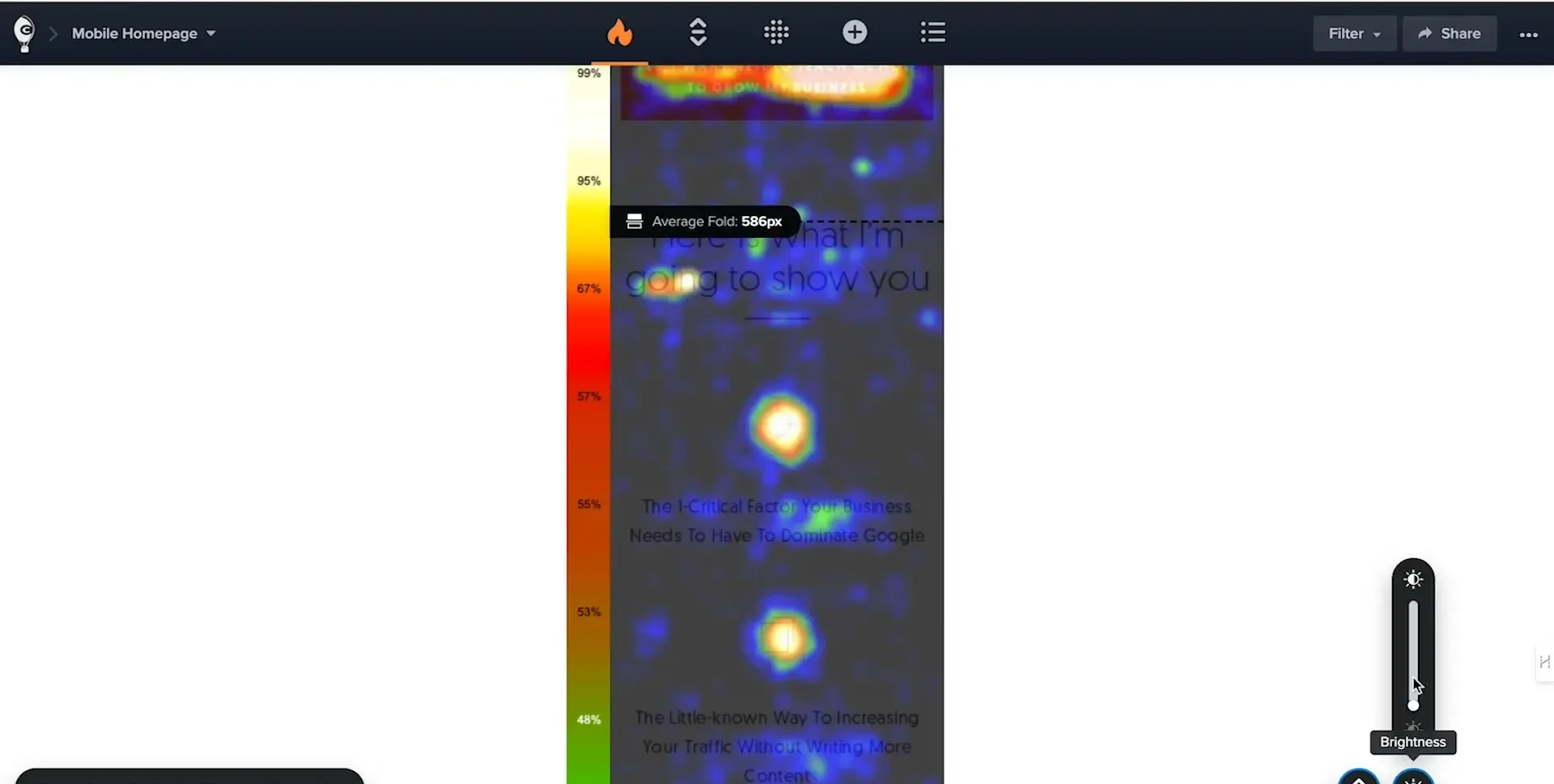
Heatmap and scrolling analysis result of Crazy Egg.
Recording analysis allows you to see exactly what the user is doing and what is stopping them from navigating your site.

List of recorded user sessions that you can analyze with Crazy Egg.
Once you understand the results on your product pages or landing pages, you can start editing them using the AB testing tool built into Crazy Egg.

A potential positive effect on Conversion Rate using Crazy Egg.
Pros of CrazyEgg:
- Comprehensive tool: Crazy Egg is a tool that allows you to do everything from visitor journey analysis to session tracking to A/B testing in the old-fashioned manual way.
- Partially AI-Assisted: You have AI assistance when it comes to generating the product page copy and choosing the best-performing page of the A/B test.
Cons of CrazyEgg:
- Little kick-off assistance: What we found missing is a team to help you create the best-performing layout along with an algorithm that can change the layout of your pages without your intervention (a thing that Vmax by Verbolia can do).
- No automated product recommendations: The algorithm doesn’t help to increase conversion rates by adding more product recommendations. It can’t modify your pages (A feature that we included in Verbolia Vmax).
- No multivariate testing: This means that the software won’t tell you which layouts and recommendations work best for each product and situation. You still have to do all the editing yourself, based on the data you analyze yourself. No AI help here.
So if you need a tool that lets you analyze customer behavior on your site with heatmaps and recordings, then you want to use that data for some manual A/B testing. And you don’t need to fully automate the A/B testing with AI technology, Crazy Egg might be the choice.
5. Hotjar
Hotjar is an ecommerce conversion rate optimization tool that puts a lot of effort into improving what they call product experience design.
Hotjar’s goal is to understand your visitors’ behavior and adjust your website accordingly.
You won’t be able to edit your product pages from within Hotjar itself. It is best used to understand why your customers are leaving so you can better optimize your Google Shopping or SEO campaigns.
Imagine being able to see the screen recordings of people that land in your product pages directly from your Google Ads campaigns. That you can do with Hotjar.
With Hotjar, you can analyze the behavior of your visitors thanks to heatmaps and session records. You’ll know exactly where they’re going and where your site can improve.
To start using it, you’ll need to install a tracking code into your website code or set it up through major platforms like WordPress, Shopify, or Wix, depending on what you’re using. Once that’s done, you can start analyzing the heat maps.

A heatmap analysis using Hotjar.
This allows you to optimize the conversion of your pages by identifying and eliminating navigation bottlenecks. Finding these bottlenecks can also be done by analyzing the records of your visitors’ sessions.
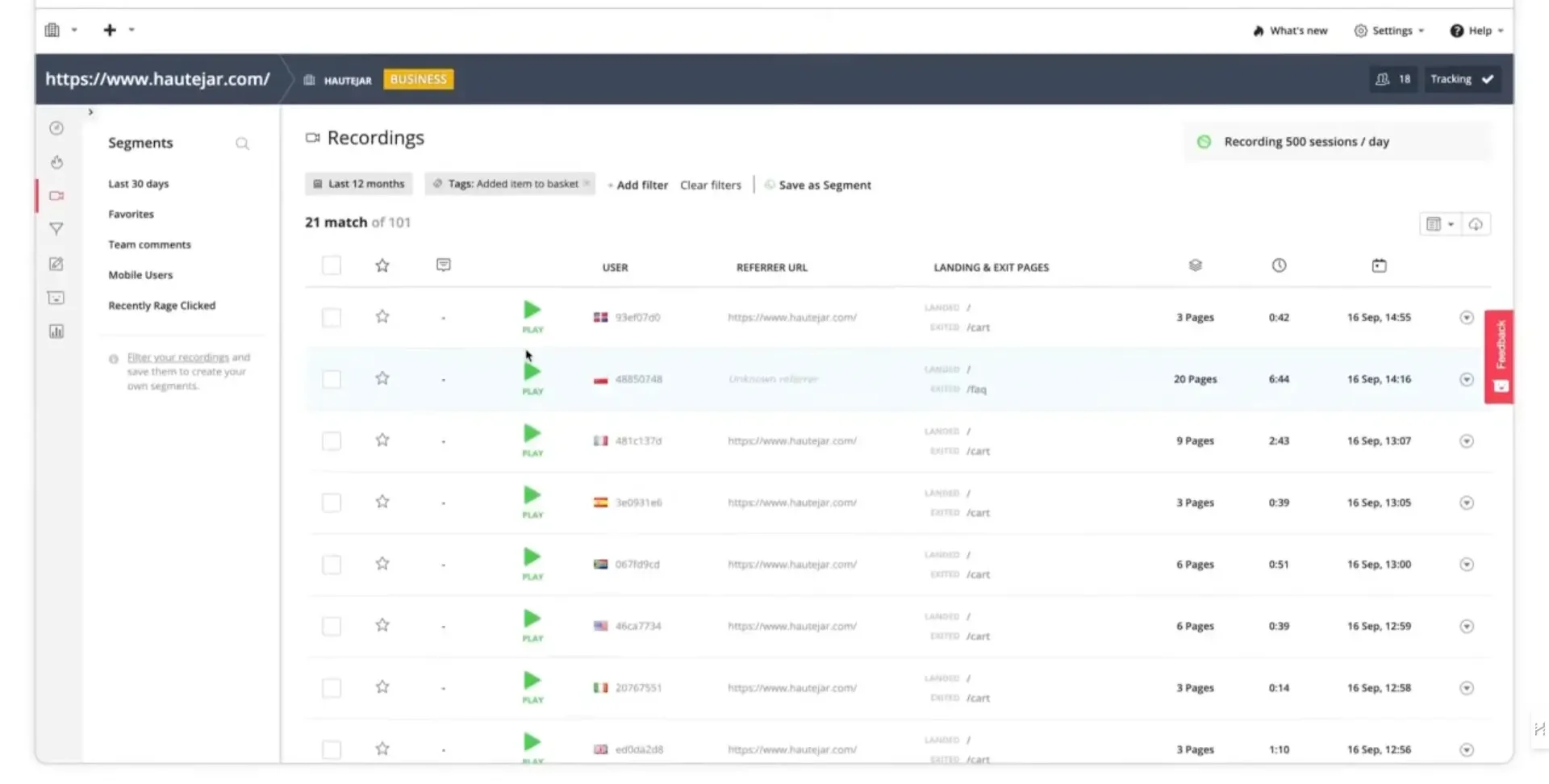
A list of user session records that you can analyze with Hotjar.
After discovering a problem, you can even ask your visitors for direct feedback to better address the problem they had with your pages.

An example of how to create a feedback question using Hotjar.
If the customer abandons the cart, Hotjar allows you to trigger an automated message to understand what the bottlenecks are in their journey that are preventing them from purchasing the product.
Or if the user leaves the product pages, you can capture insights on why the leave, then improve and increase conversion rates.
Hotjar’s process makes it easier to deliver the ideal UX to your visitors, guiding them step-by-step to the checkout.
It’s important to note that this process is manual, meaning that you don’t have an algorithm making changes to the product pages for you.
Pros of Hotjar
- Detailed Analysis: Based on heat maps and session recordings. You can exactly know what your site visitors are doing.
- Quick Installation: You’ll need to install a tracking code into your website code.
- Automatic Messaging: In case a customer leaves the cart, you can send a message to understand what’s the problem.
Cons of Hotjar
- Manual: The analysis is done by the software, but the conclusion must be made by you. So the changes. You don’t have an algorithm doing the layout changes or product recommendations for you to increase the conversion rate (We included this feature in Verbolia Vmax).
So if you need a conversion optimization tool with AB testing capacities that shows you the user journey with recordings and heatmaps, and you don’t need an AI to do the product page customization for you, this tool could be considered.
6. OmniConvert
Omniconvert is a CRO software and it’s designed for ecommerce. As usual, to start using this A/B testing tool, all you need to do is install a line of tracking code into your site code.
Once you’re in, you can start adjusting your product landing pages with their visual editor to change the most basic elements of your website.
Unfortunately, for more complex changes you still need a developer to manage the code in the Advanced Editor, a thing that Vmax by Verbolia does for you automatically thanks to AI (it changes entire layouts, and recommends products based on data).

The visual editor of Omniconvert.
You can also submit some custom surveys to your customers, to better understand what’s their opinion of your products or what bottleneck they got with your product pages.

Omniconvert’s survey creating tool.
You can even edit the product pages with custom segmentation parameters based on the visitors’ location, like in the image below:

Product pages editor with custom segmentation parameters based on site visitors.
The final result? Something like this:

At the end of your A/B testing, you can analyze a PDF report to help you make your next decisions. The report includes conversion rate trends, revenue per visitor, average order value, and more.
But that means you still have to do the manual work of deciding what to do next in terms of product page optimization.
Having an AI do this for you (as Verbolia’s Vmax does), from decision-making to implementation and layout changes, is a feature that will help you with time efficiency without ROAS optimization.
Pros of Omniconvert
- Quick Editor: The visual editor can help you do the most basic edits to your pages without too much effort.
- Custom Surveys: This will help you understand what is the bottleneck of your site users.
- Custom Segmentation: You can edit your pages based on your visitor’s parameters (location, weather, +38 more).
Cons of Omniconvert
- Limited Editor: The visual editor of Omniconvert can be used only for basic edits. If you want more complex edits, you still need a developer.
- No AI assistance: Using Omniconvert the decisions and the edits must be all done manually by you.
So if you need testing software that is also a CRO that integrates with email marketing (yes, it does), Omniconvert could be the solution you need. But if you want a fully automated product landing page optimizer that can adjust pages based on traffic source (PPC or SEO), you may need to look elsewhere.
💡Optimize your PPC campaigns with the best Google Ads tool stack
7. HubSpot
HubSpot offers a ton of marketing tools, including some that can be helpful for your e-commerce conversion rate optimization (CRO).
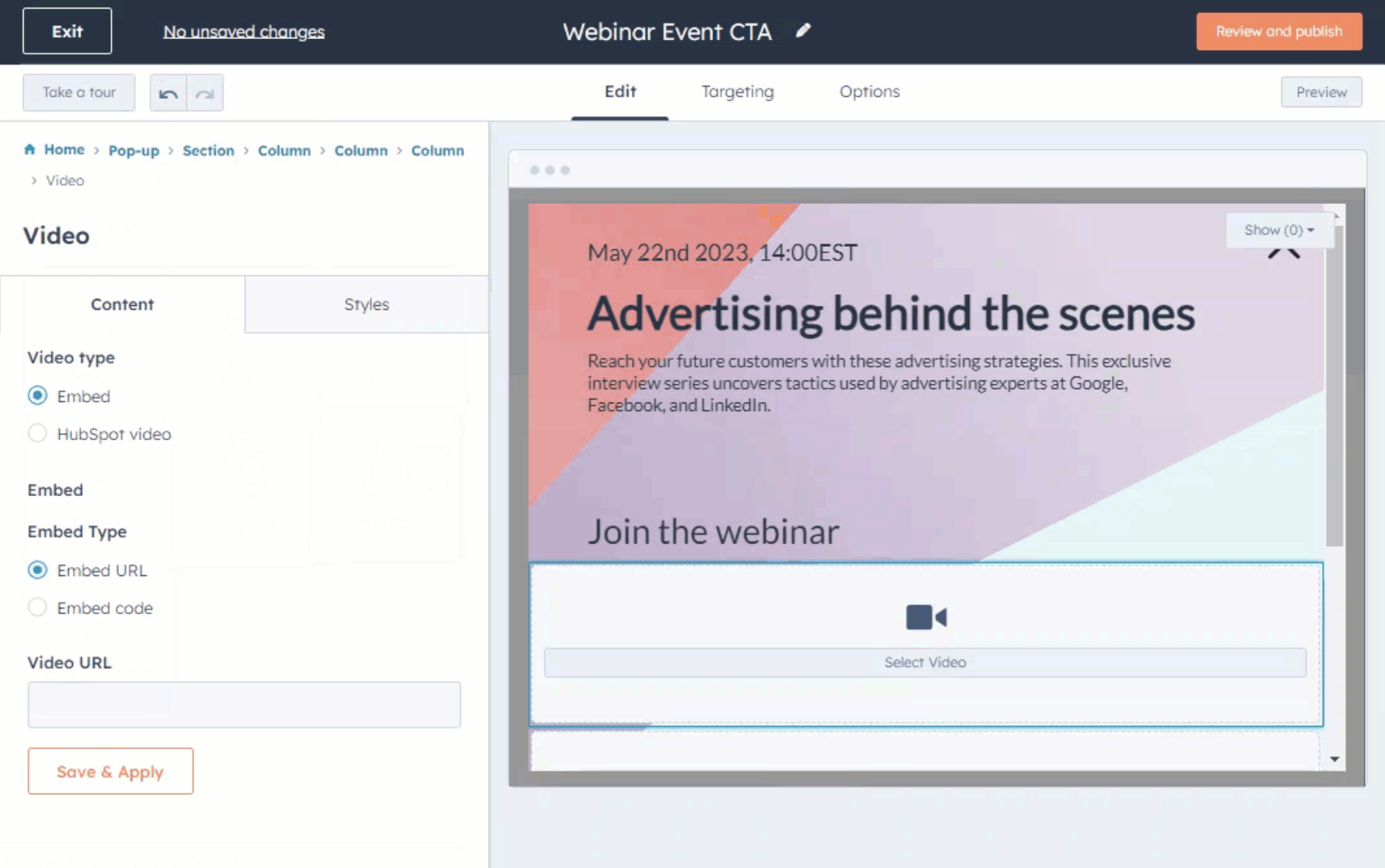
A CTA editor within Hubspot.
It is possible to integrate Hubspot with some of the main e-commerce platforms like WooCommerce, and Shopify.
With some features included in the free plan, Hubspot could help you with form creation, landing page optimization, and site analytics to understand if something is not going as you need.
But keep in mind that the free plan has limited features. The A/B testing is also included, but not in the free plan. It lets you test headlines, CTAs, and page layouts. But it’s not AI-generated like Verbolia. You still need to do the heavy lifting manually!
Hubspot is huge but is not a fine-tuned CRO. It has many things together. So you might feel the absence of some more CRO-oriented tools.
Pros of Hubspot:
- Freemium model: HubSpot offers a free tier with basic CRO features. If you’re a small business and want to start doing some basic CRO, you can.
- Integrations: HubSpot integrates with various e-commerce platforms like Shopify and WooCommerce. This allows you to seamlessly connect your website data with HubSpot for a more holistic view of your customer journey.
Cons of Hubspot:
- Not a dedicated CRO tool: It’s not a specialized conversion rate optimization platform. So you don’t have some advanced AI that will adjust the pages based on the site visitor (like Verbolia does).
- Learning curve: Mastering all aspects might require some familiarization for new users. And you don’t have a team of specialists that will do the initial layout upload together with you to start the AI-assisted A/B Testing.
- Price: For some CRO features like A/B Testing you need a professional plan which starts from $500!
So if you’re already using Hubspot for your marketing strategy and benefitting from its CRM features, this CRO tool could help you. Otherwise, the pricing and the fact that it is not a CRO-only tool might make you look elsewhere.
8. Google Analytics
Google Analytics (GA4) is a free web analytics platform that every ecommerce store should have in place. With Google Analytics you can analyze user demographics and behavior tracking. Analyzing your site visitors in such a detailed way, allows you to identify areas for improvement and track the effectiveness of your CRO efforts.
You can also have customizable dashboards and reports to tailor your analysis to specific e-commerce goals, such as conversion rates for different product categories or marketing campaigns.
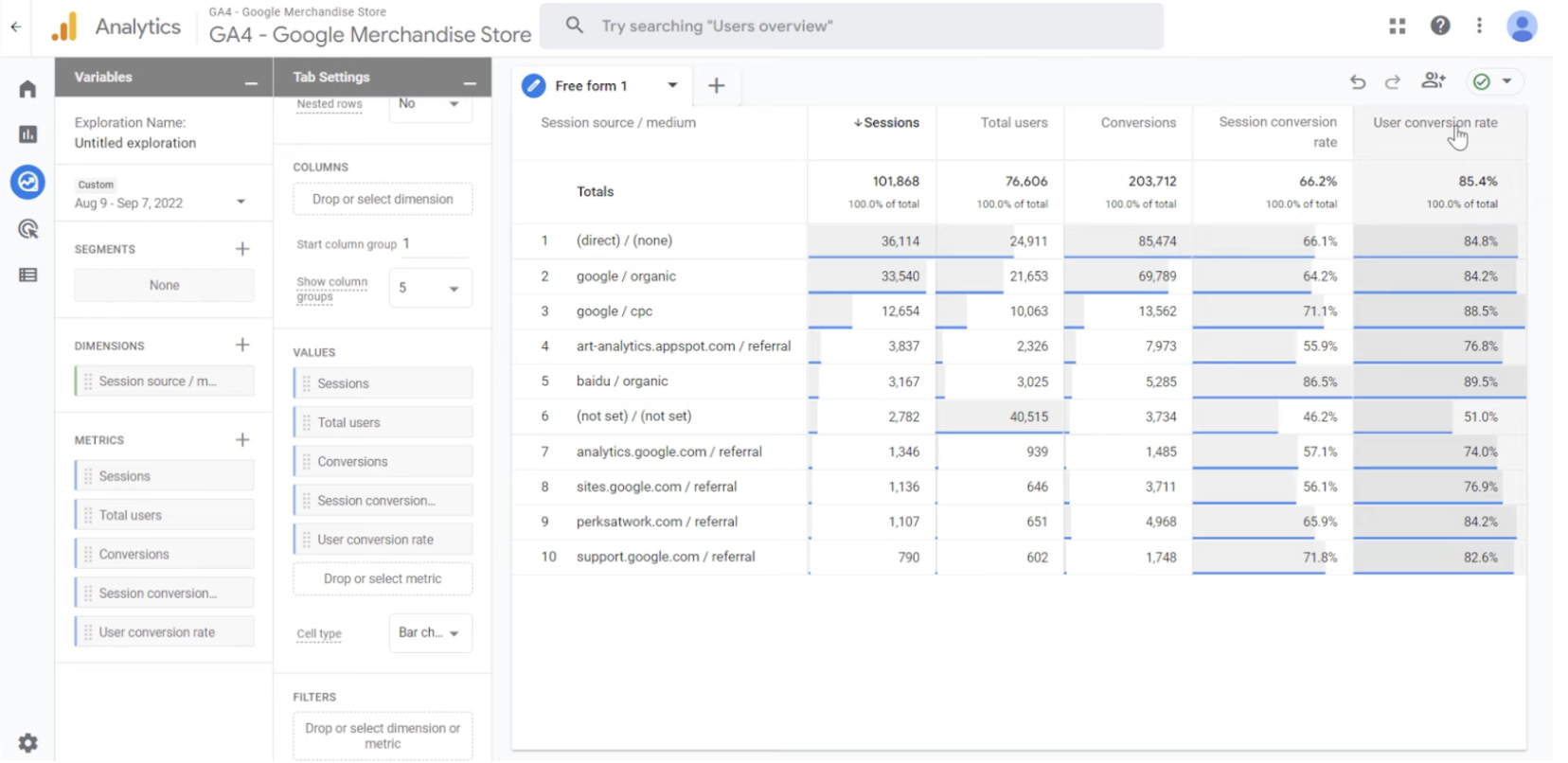
User conversion rate and other data displayed using Google Analytics 4.
Using GA4 you can also track user behavior throughout the purchase funnel, from product views to cart abandonment and checkout completion. But being an almost daily GA4 user, I can tell you that the amount of data you have altogether could be sometimes complicated to manage. Especially if you’re using GA4 for the very first time.
Also, you can’t perform any A/B testing with Google Analytics 4 alone. You’ll always have to install some third-party software.
Pros of GA4:
- Free and feature-rich: Wide range of features like website traffic analysis, user demographics, user behavior tracking, and goal setting.
- Customizable dashboards and reports: GA provides customizable dashboards and reports to tailor your analysis to specific e-commerce goals, such as conversion rates for different product categories or marketing campaigns.
- Ecommerce tracking: GA offers built-in e-commerce tracking features that allow you to track user behavior throughout the purchase funnel.
Cons of GA4:
- Steeper learning curve: GA offers a vast array of features and data points. It could take some time to learn how it works (check their academy to do this).
- Limited A/B testing: GA doesn’t offer built-in A/B testing functionality since Google Optimize has been dismissed. You’ll need to integrate it with separate tools for split testing different website elements.
- Data overload: With so much data available, it can be overwhelming to identify the most relevant insights for your CRO efforts.
9. SurveyMonkey
SurveyMonkey is a popular online survey platform that can be a helpful tool for gathering customer feedback to inform your e-commerce CRO strategy. So no space for heatmaps, session recordings, or AI Optimized Product pages. Once you have registered on the platform (they have a free plan too in case you think it’s a good fit for you), you’re ready to go.
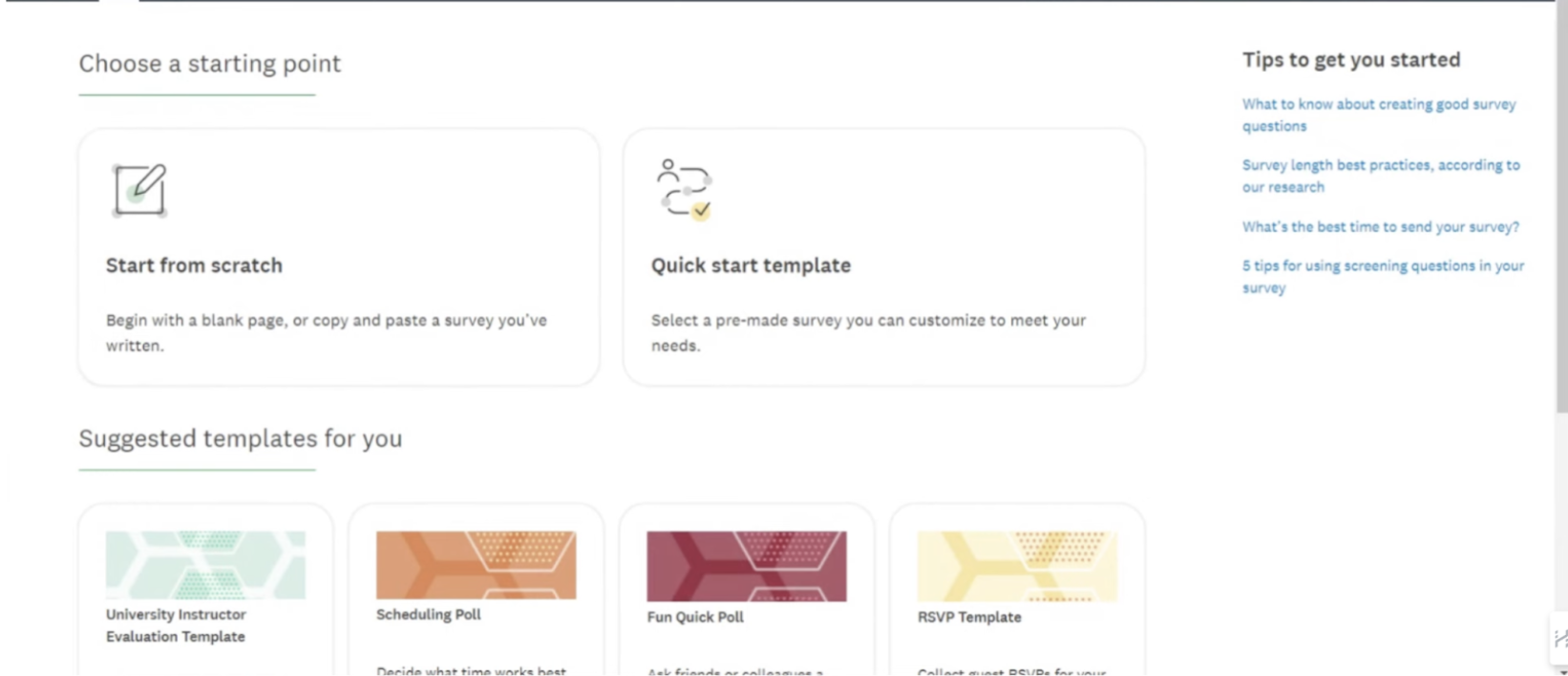
The first page of SurveyMonkey editor.
You’ll have a question for every page. So in case you want a separate Survey on each page, you need to create another one. The survey editor will give you the possibility to choose the question you wanna make.
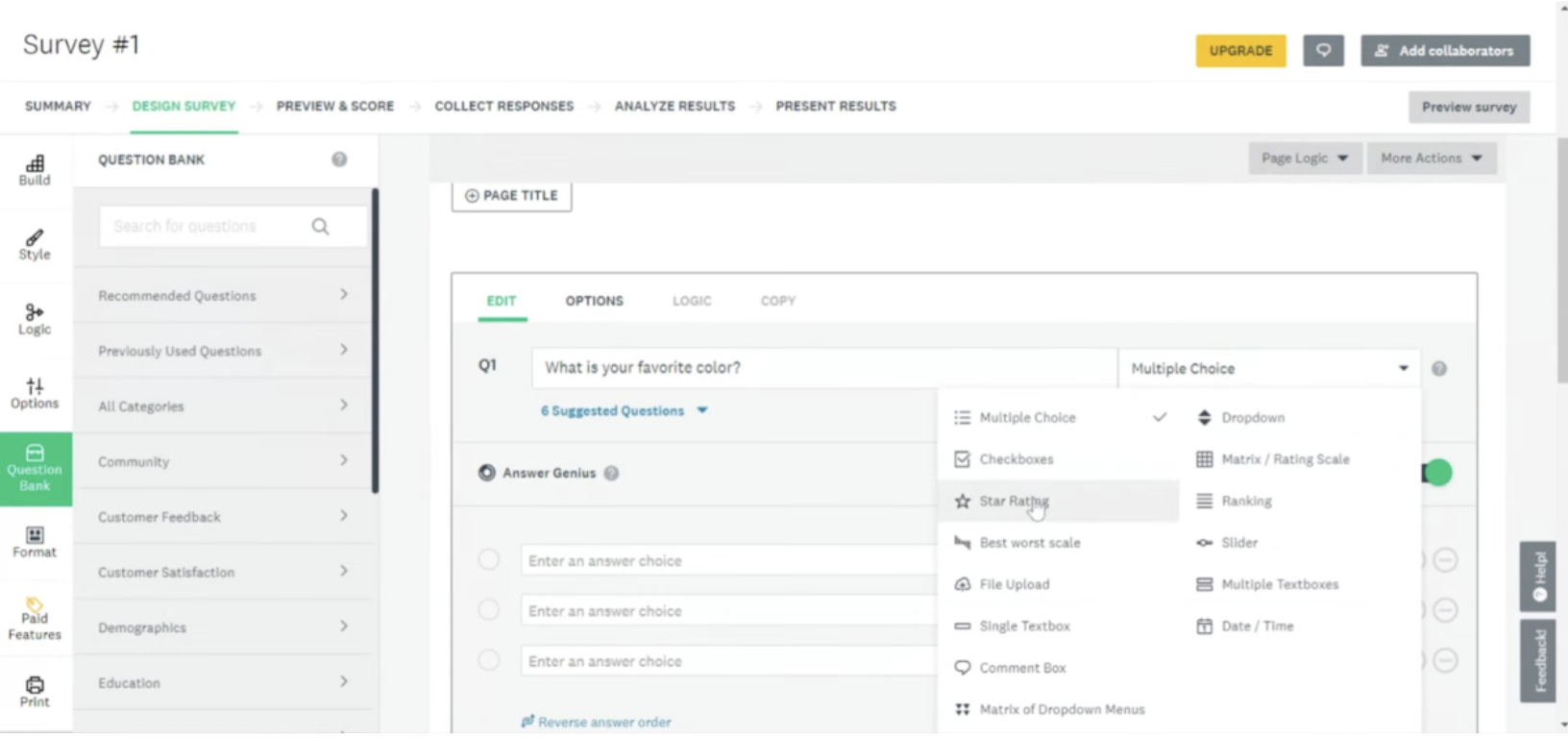
SurveyMonkey’s survey editor.
Once you have created your Survey, you can also decide how to send it out to people. You can choose between “share the link”, “social media”, and “website” plus many other options like email included in the premium plan.
Pros of SurveyMonkey:
- User-friendly interface: It’s easy to create and deploy surveys even for non-technical users.
- Variety of question types: Open-ended questions, and image-based questions are all here. This allows you to gather diverse feedback from your customers.
- Customer segmentation: Segment your audience based on demographics, purchase history, or other criteria. Lets you gain targeted insights.
- Actionable reports: You have detailed reports with visualizations and data analysis tools. These reports helps you easily identify insights from your customer feedback.
Cons of SurveyMonkey:
- Limited free plan: The free plan of SurveyMonkey offers basic features with a limited number of questions and responses.
- Not a dedicated CRO tool: It doesn’t offer A/B testing or other core CRO functionalities like AI-generated layouts or Pages personalized based on a visitor’s journey and behavior by collecting activity data.
- Survey fatigue: Sending too many surveys can lead to “survey fatigue” and decrease response rates.
How did we choose these e-commerce conversion rate optimization tools?
- Conversion Rate Optimization Options Offered: We evaluated each eCommerce conversion rate Optimization tool based on the features it offers:
- Can it Modify product detail pages?
- Does it have Automated templates for A/B Testing?
- Does it offer Automated product recommendation engines?
- Are pages personalized based on a visitor’s journey and behavior by collecting activity data?
- Pay Attention to the Algorithm: We checked if the recommendations have an advanced machine learning technique behind them or are supported with large sets of data and AI technology. That will translate into relevant tailored products for each user increasing conversion rates.
- Uses large sets of data?
- Uses 3rd party or 1st party data?
- Does it react real time?
- A/B Testing Included: We put particular importance on CROs that allow you to A/B testing one way or another: layouts, settings, multiple platforms, devices, etc. Still, you will also find tools that do not offer this feature as Survey Monkey (it does conversion rate optimization by having answers from your site visitors) or GA4 (it needs a third-party software).
- Industry-specific CROs: We considered how each ecommerce CRO is tested in a specific environment. We focused mostly on solutions that serve online retail within consumer products, where we believe these product recommendation engines have better results.
- User-friendly CROs: Most e-commerce conversion rate optimization tools are full of features, which means that the complexity increases. In many cases, you need front-end development to use the engines to their full potential, but many companies cannot do that. We also listed conversion tools that require no technical customization so you can use them without any limitations because of a lack of technical knowledge or resources.
- Customer Support: We did not reach all customer support teams of each company that provides a conversion tool (only a few of them) and we listed the best ones in terms of service. You might have to experience it for yourself. But we listed the best-rated companies.
FAQs
How do I optimize my eCommerce website for conversions?
To optimize your eCommerce conversion you need to:
- Craft clear product descriptions & high-quality images.
- Simplify your checkout process and offer guest checkout.
- Make your website mobile-friendly for on-the-go shoppers.
- Use strong calls to action (CTAs) to guide visitors.
- Offer free shipping or attractive promotions.
- Leverage heatmaps to see how visitors interact with your site.
- A/B tests different elements to see what drives more sales.
- Use an AI powered conversion optimization tool like Verbolia.
What can an e-commerce marketer do to help improve a product conversion rate?
To help improve a product conversion rate you can use an AI-powered tool made to increase product conversion rates. Some tools allow you to perform A/B Testing with page layouts that are 100% AI-made. The algorithm does all the analysis for you and decides the best setup for your ecommerce site.
How to improve CRO on landing pages?
To improve CRO on landing pages you should:
- Craft a compelling headline that speaks to visitor needs.
- Highlight the benefits of your offer with a clear and concise copy.
- Use high-quality visuals that resonate with your target audience.
- Include a strong call to action (CTA) that’s easy to find.
- Remove distractions and simplify the landing page design.
- Optimize for mobile responsiveness to ensure a great user experience.
- A/B tests different elements to see what drives more conversions.
- Use heatmaps to understand visitor behavior and identify areas for improvement.
- Provide size selection help for clothing items to reduce uncertainty and increase confidence in purchases.
Boost your conversion rates automatically with Verbolia
Increase Your Conversion Rate on PPC Campaigns


